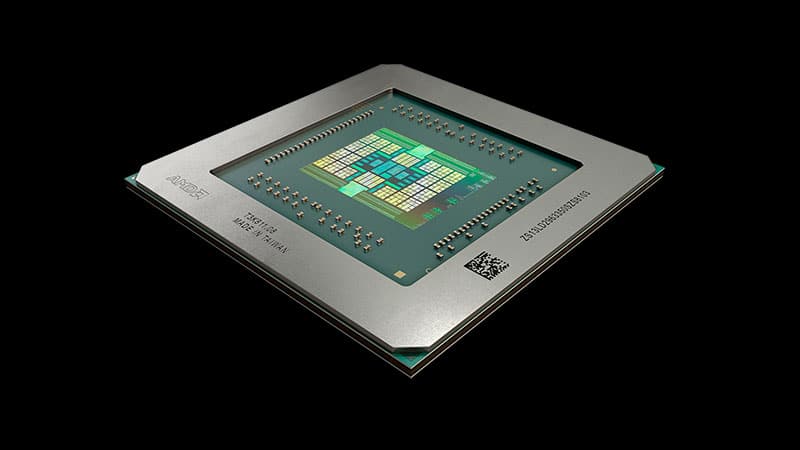Review and testing of the AMD Radeon RX 5700 video card: strike back: The July announcement of the new AMD RDNA (Radeon DNA) graphics architecture, new Navi GPUs and AMD Radeon RX 5700 and Radeon RX 5700 XT graphics cards rocked the 3D graphics market like the recent Hurricane Dorian in the Bahamas.
The expectations from these new products were so serious that AMD’s eternal rival NVIDIA preemptively updated its RTX models, accelerating them in SUPER versions and keeping the same prices. However, this did not make the Radeon RX 5700 (XT) less interesting, on the contrary, in September the original versions of these models of video cards with effective cooling systems and original printed circuit boards should go on sale.
Surely we will also be able to get them for testing, but in today’s article we will get acquainted with the still most widely presented version of the Radeon RX 5700 in the reference version and compare its performance with competitors.
Immediately, we note that today’s article is devoted only to the practical part, and you can get acquainted with the theory of the new architecture from the materials already available on the network or from the official AMD documentation .
1. Review of the AMD Radeon RX 5700 8 GB video card
Technical Specifications and Recommended Cost Technical characteristics and cost of the AMD Radeon RX 5700 video card are shown in the table in comparison with the reference versions NVIDIA GeForce RTX 2060 SUPER Founders Edition and RTX 2060 FE.
Packaging and packaging We were provided with a reference sample of AMD Radeon RX 5700 for testing, sealed in a small but stylishly designed black box.
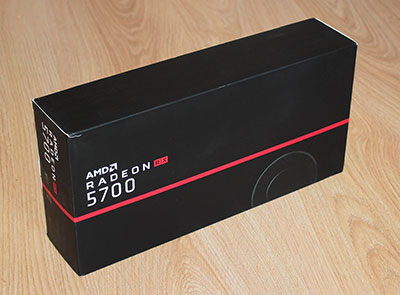
The model name and serial number are printed on the back of the box.
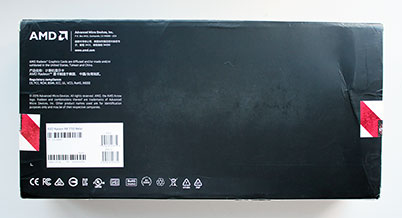
Inside the box is a cardboard pallet containing a brief instruction and a warranty memo.
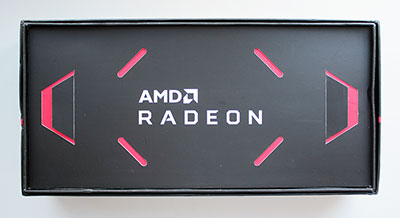
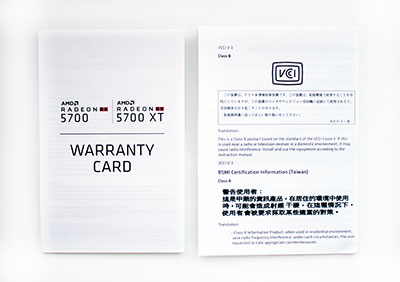
Under it, in a special compartment, a video card is fixed, reliably protected from external influences. The AMD Radeon RX 5700 has a two-year warranty, and its cost in Russian “retail” starts at 25 thousand rubles, which, oddly enough, corresponds to the price level recommended by AMD for this model.
PCB Design and Features The AMD Radeon RX 5700 reference design is exceptionally clean. At its core, the video card is a “bar” with a hole for the fan, where it is installed, framed by a chrome ring. On the front on the casing there is a scarlet inscription “RADEON”, and that’s it.
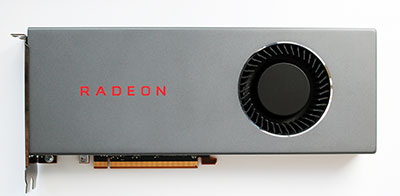
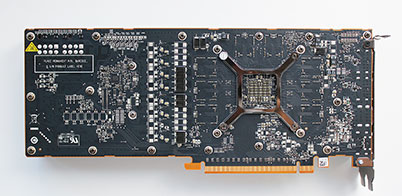
But the reverse side of the PCB is not covered by anything, and from the hinged elements there is only a cross-shaped reinforcing bar opposite the GPU. The shroud covers the graphics card not only from the front, but also from the top and bottom, directing the entire fan airflow through the radiator of the cooling system.
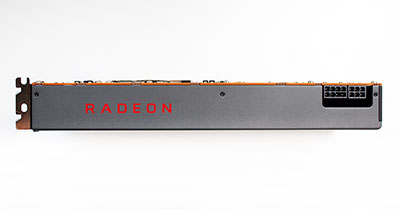
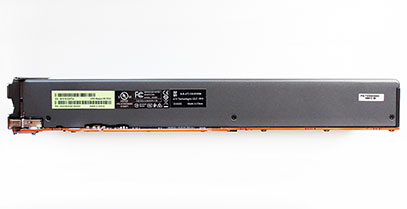
To eject this flow, the panel with outlets is maximally perforated. Even the video outputs are offset to the edge of the panel as much as possible. These include one HDMI version 2.0b and three DisplayPort versions 1.4a.
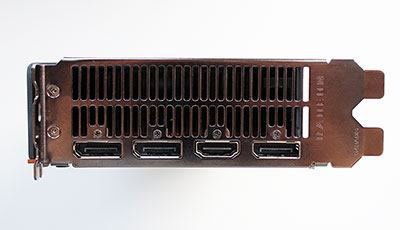
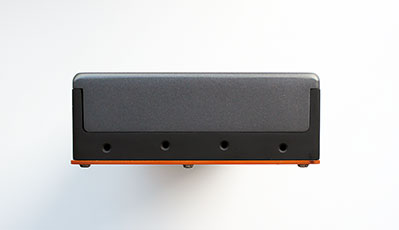
The opposite end of the video card is completely blind. Let’s add that the dimensions of the video card are 220 × 100 × 36 mm, and it weighs about one kilogram. The video card is equipped with two power connectors: six- and eight-pin.
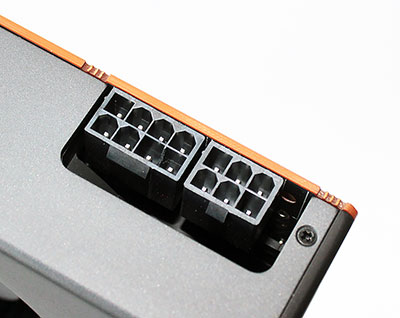
According to AMD specifications, the Radeon RX 5700 should consume no more than 180 watts, and for a system with one such video card, AMD recommends a power supply with a capacity of at least 600 watts. Unfortunately, we were not allowed to disassemble the video card (the GPU uses a highly efficient graphite gasket that collapses when removed), so in the brief description of the printed circuit board and cooler, we had to make do with the information that AMD provided. The GPU is powered by six phases on FDMF3170 elements manufactured by ON Semiconductor with a current of up to 70A each. Another phase is reserved for memory and power circuits. Power management is assigned to the IR35217 controller, which is soldered on the back of the PCB.
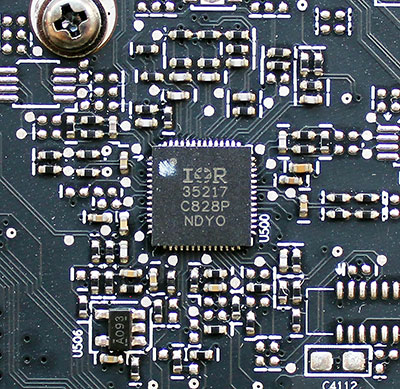
As a GPU, the AMD Radeon RX 5700 uses a seven-nanometer Navi 10 Pro with a die size of 251 mm2, consisting of approximately 10.3 billion transistors.
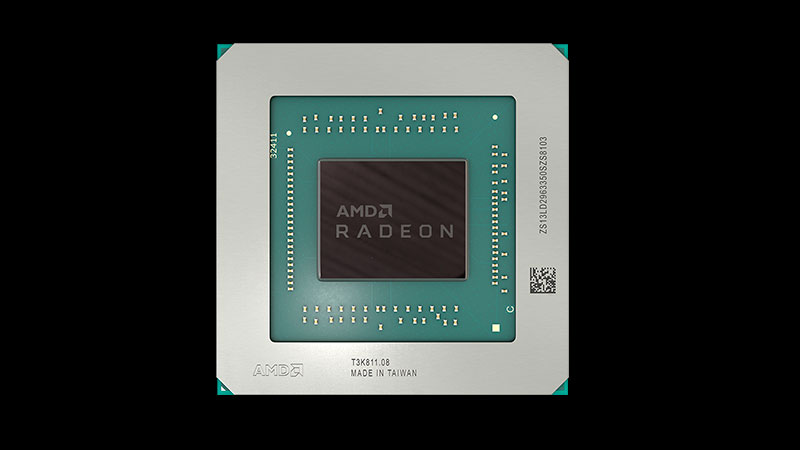
Apart from the huge number of architectural changes in Navi 10, the basic parameters of the GPU are as follows: 2304 shader ALUs, 144 texture units and 64 rasterization units (ROPs). The base frequency of the GPU is 1465 MHz, and the maximum boost frequency can reach 1725 MHz. The latter value can be called conditional, since it directly depends on the cooling efficiency and the degree of load. As for the video memory, its volume on the AMD Radeon RX 5700 is 8 GB. GDDR6 operates at an effective frequency of 14 GHz, providing 448 GB / s bandwidth on a 256-bit bus. At the time of writing, the latest available version of the GPU-Z utility was not yet fully familiar with the characteristics of the AMD Radeon RX 5700, but we will still provide screenshots of it.
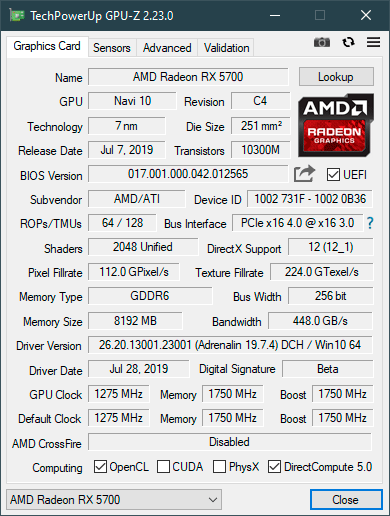
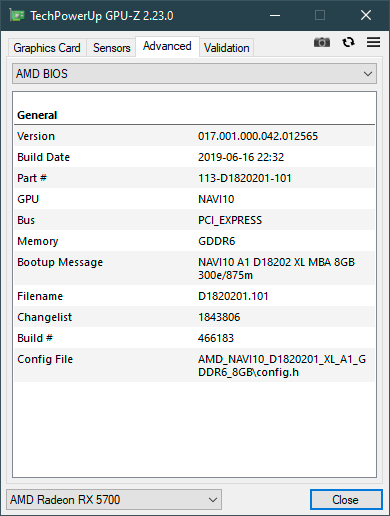
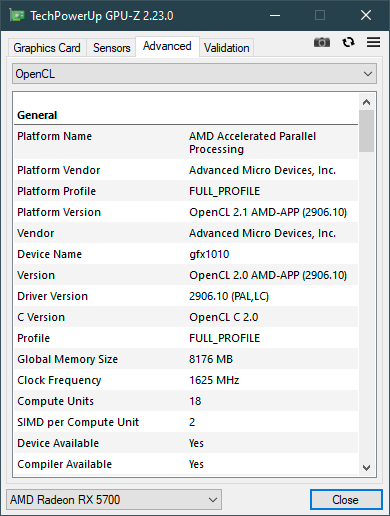
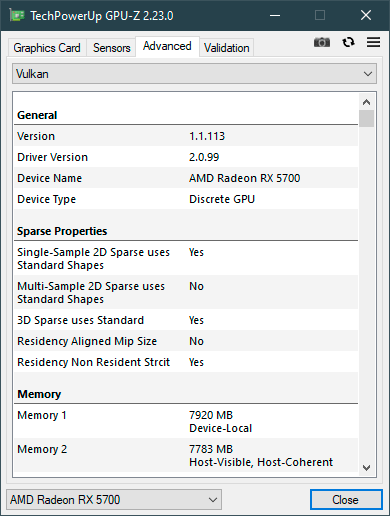
Cooling system The design of the AMD Radeon RX 5700 cooling system is made according to the classical scheme and is shown in the following photo.
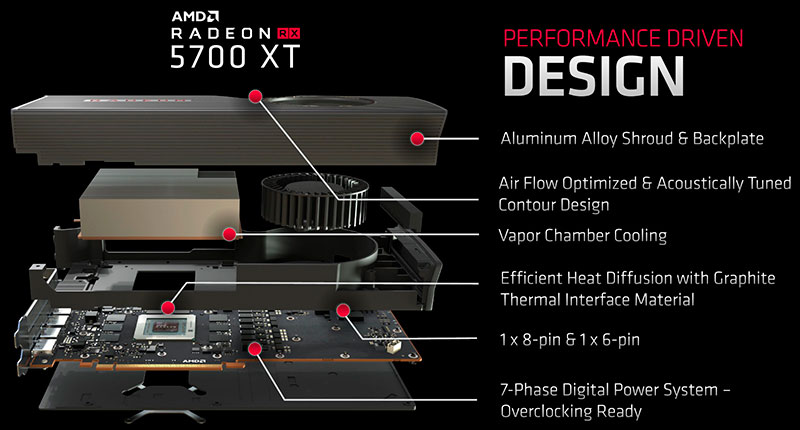
It is based on an aluminum radiator with a copper evaporation chamber at the base. It is solely responsible for cooling the GPU. To reduce the temperatures of power circuit elements and video memory chips, a massive metal plate with thermal spacers is provided. The entire structure is cooled by a powerful radial fan manufactured by Delta Electronics, the speed of which is controlled by pulse width modulation. We used the Fire Strike Extreme stress test from the latest version of the 3DMark graphics package to test the temperature regime of the video card as a load.
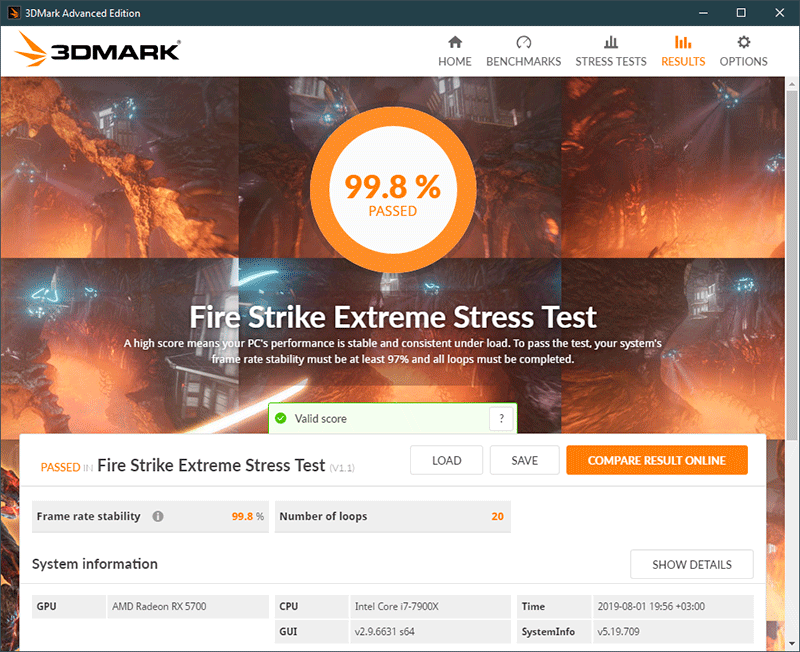
To monitor temperatures and all other parameters, MSI Afterburner version 4.6.2 Beta 2 and GPU-Z utility version 2.22.0 or later were used. The tests were carried out in a closed case of the system unit , the configuration of which you can see in the next section of the article, at a room temperature of about 26 degrees Celsius. First, we checked the temperature conditions of the AMD Radeon RX 5700 with automatic fan speed control.
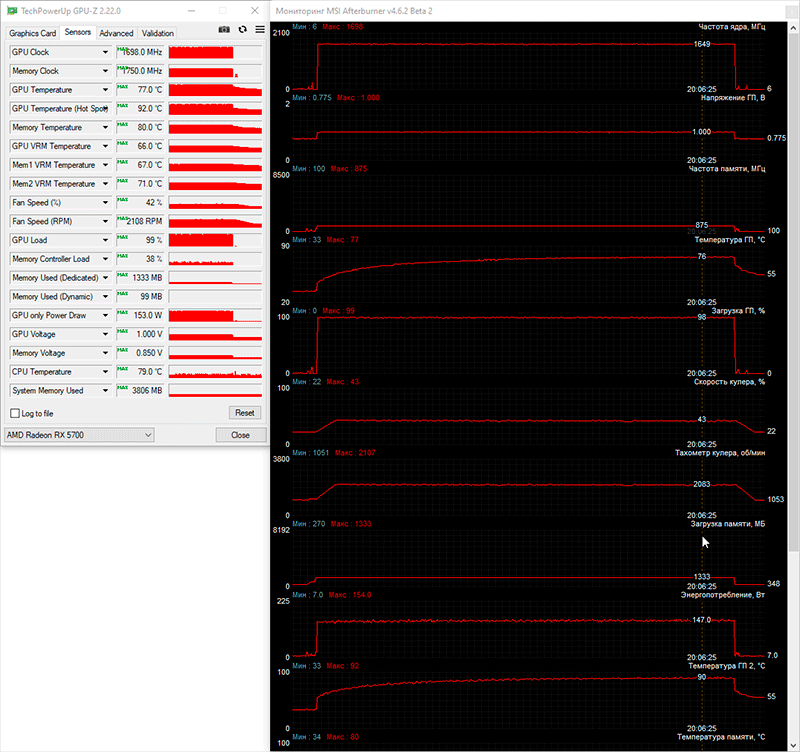
Automatic mode (1050 ~ 2110 rpm)
As you can see, the temperatures are quite high. The GPU hit 77 degrees Celsius (92 degrees Hot Spot), the memory hit 80 degrees, and the VRM circuitry hit 66 degrees Celsius. At the same time, the fan speed increased from 1050 to 2110 rpm and the video card began to make a noticeable noise. The GPU frequency during testing averaged 1650 MHz, which, in our opinion, is a very good indicator for a reference video card with a stock cooler. It is possible to significantly reduce all temperatures of the AMD Radeon RX 5700 by increasing the fan speed of the cooler to the maximum possible 4500 rpm.
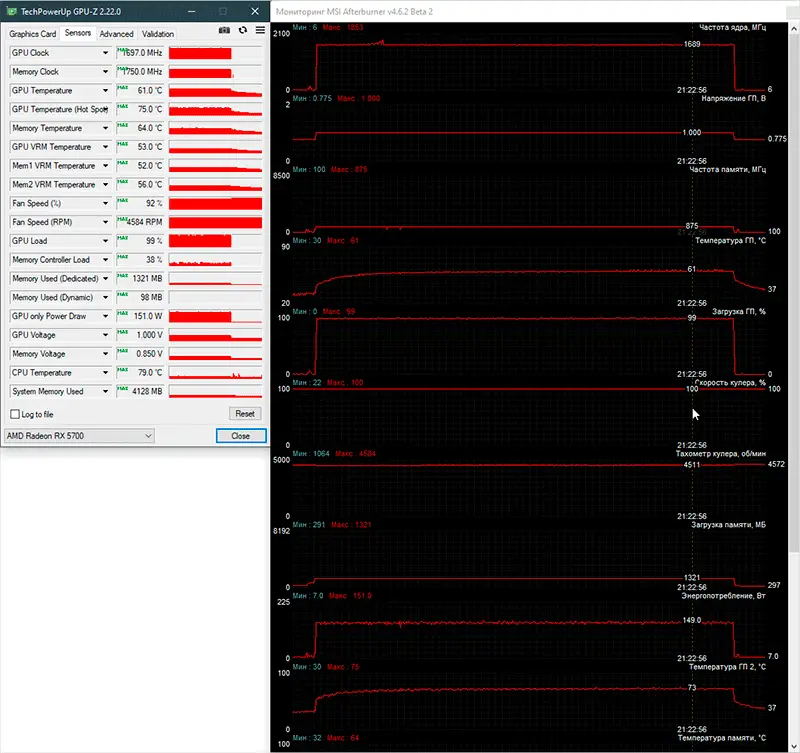
Maximum speed (~ 4580 rpm)
In the mode “Where are my earplugs ?!” GPU temperature of the video card dropped to 61 degrees Celsius, memory – to 64 degrees, and VRM – to 53. The GPU frequency stabilized at around 1690 MHz. If the original models of video cards with efficient coolers can provide the Radeon RX 5700 with the same temperature conditions at a radically lower noise level, then that will be just great. The final test of the temperature regime of the AMD Radeon RX 5700 was the selection of the lowest possible voltage on the graphics processor, at which the video card could work without loss of stability and performance. As a result, we were able to reduce the voltage on the GPU from 1,000 V to 0.925 V, which led to a slight decrease in temperatures and an adjustment of the maximum fan speed towards a decrease of 250 rpm.
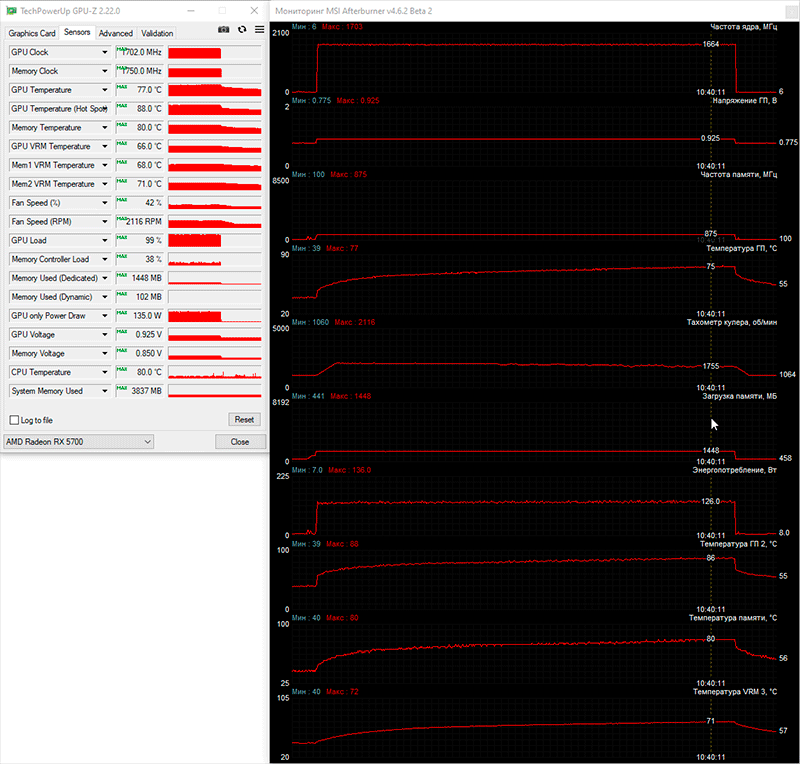
Automatic mode (1050 ~ 1760 rpm)
As a result, the video card has become a little quieter and slightly more stable in terms of the frequency of the GPU.
Overclocking potential Overclocking the new AMD Radeon RX 5700 (XT) is not literally overclocking. It would be more correct to say that this is the selection of the optimal combination of frequencies of the video card, the voltage of its GPU and the power limit with the most efficient cooling. The latter, in the case of the reference version AMD Radeon RX 5700, could only be achieved by manually increasing the fan speed, which we did before testing, fixing it at 3000 rpm.
On the AMD Radeon RX 5700 reference version, you cannot simply raise the power limit to the maximum, increase the voltage, and raise the GPU frequency. This whole process is a painstaking and many hours test in search of a balance between power consumption, frequency with voltage and temperatures. So it happened in our case, when in total it took not a couple of hours, as usual, to check the overclocking potential of a video card, but about three times more. As a result, it was found that the optimal and stable frequency of the GPU can be increased to 2000 MHz by increasing the voltage to 1.075 V and increasing the power limit by 14-15%.
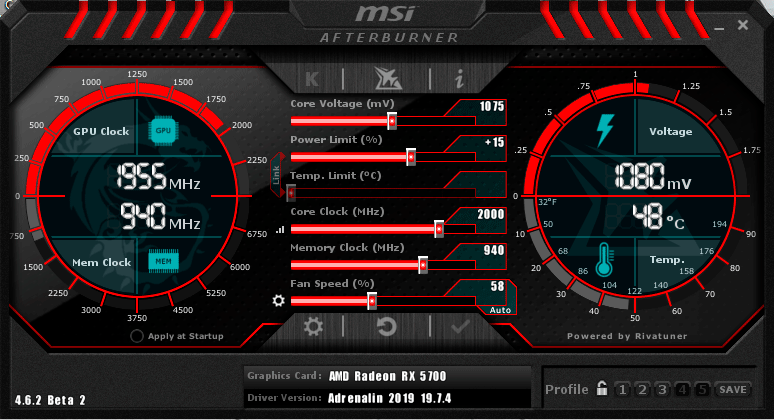
In turn, we overclocked the GDDR6 video memory to 1040 MHz.
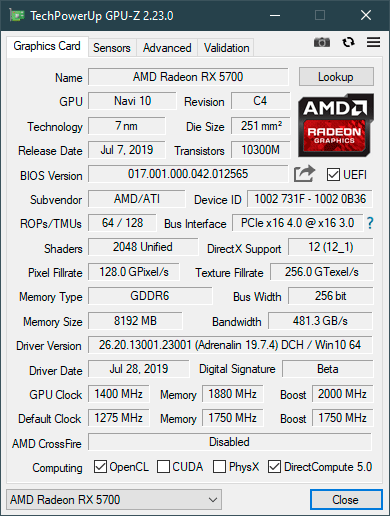
All this, coupled with the roaring fan of the cooler at 3000 rpm, allowed us to achieve stability from our AMD Radeon RX 5700 at 1900 MHz for the GPU and 15040 MHz for the video memory.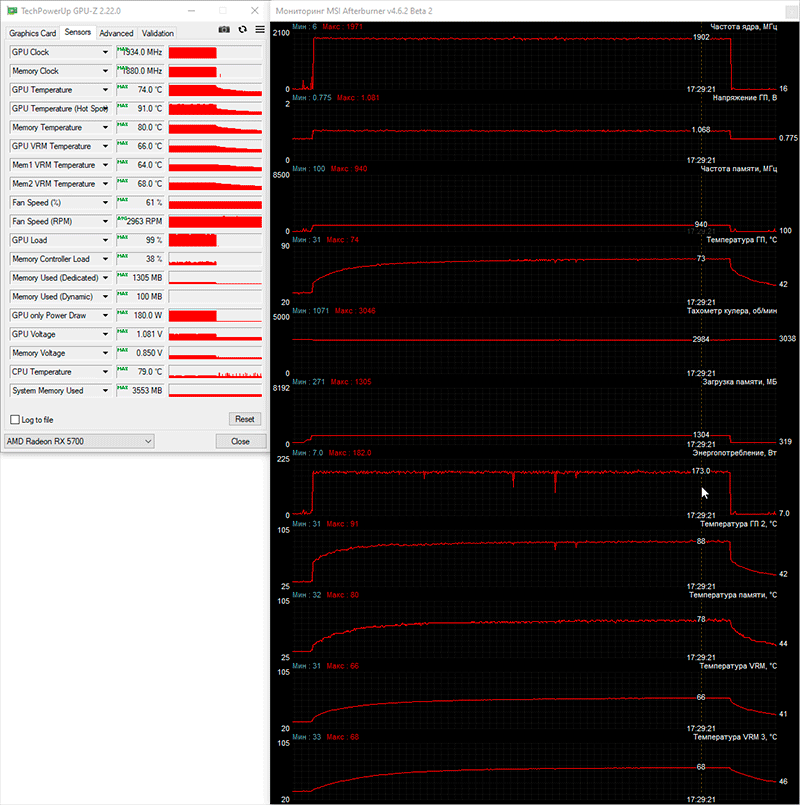
58% power (~ 3000 rpm)
We were quite satisfied with the result, especially when we saw the performance gains brought by such overclocking of AMD Radeon RX 5700. By the way, speaking of performance.
2. Test configuration, tools and testing methodology
The video cards were tested in a closed system case on the following hardware configuration:
motherboard: ASRock X299 OC Formula (Intel X299 Express, LGA2066, BIOS P1.60 from 01.11.2018);
central processor: Intel Core i9-7900X 3.3-4.5 GHz (Skylake-X, 14 nm, U0, 10 × 1024 KB L2, 13.75 MB L3, TDP 140 W);
CPU cooling system: Phanteks PH-TC14PЕ (2 × Corsair AF140, 760 ~ 1090 rpm);
thermal interface: ARCTIC MX-4 (8.5 W / (m • K);
RAM: DDR4 4 × 4 GB Corsair Vengeance LPX 2800 MHz (CMK16GX4M4A2800C16) (XMP 2800 MHz / 16-18-18-36_2T / 1.2 V or 3000 MHz / 16-18-18-36_2T / 1.35 V);
video cards:
– Gigabyte GeForce RTX 2070 SUPER Gaming OC 8 GB / 256 bit, 1605-1815 (1965) / 14000 MHz;
– NVIDIA GeForce RTX 2060 SUPER Founders Edition 8 GB / 256 bit, 1470-1650 (1830) / 14000 MHz and overclocked to 1615-1795 (1965) / 15960 MHz;
– AMD Radeon RX 5700 8 GB / 256 bit, 1465-1725 / 14000 MHz and overclocked to 1900/15040 MHz;
– NVIDIA GeForce RTX 2060 Founders Edition 6 GB / 192 bit, 1365-1680 (1830) / 14000 MHz;
drives:
– for the system and benchmarks: Intel SSD 730 480 GB (SATA III, BIOS vL2010400);
– for games and benchmarks: Western Digital VelociRaptor 300 GB (SATA II, 10,000 rpm, 16 MB, NCQ);
– archived: Samsung Ecogreen F4 HD204UI 2 TB (SATA II, 5400 rpm, 32 MB, NCQ);
sound card: Auzen X-Fi HomeTheater HD;
case: Thermaltake Core X71 (six be quiet! Silent Wings 2 [BL063] at 900 rpm: three for blowing in, three for blowing out);
control and monitoring panel: Zalman ZM-MFC3;
PSU: Corsair AX1500i Digital ATX (1.5 kW, 80 Plus Titanium), 140 mm fan;
monitor: 27-inch Samsung S27A850D (DisplayPort, 2560 × 1440, 60 Hz).
To reduce the dependence of the performance of video cards on the platform speed, a 14-nm ten-core processor with a multiplier of 44 , a reference frequency of 100 MHz and the Load-Line Calibration function activated at the highest level, was overclocked to 4.4 GHz when the voltage in the motherboard BIOS was raised to 1.119 V.
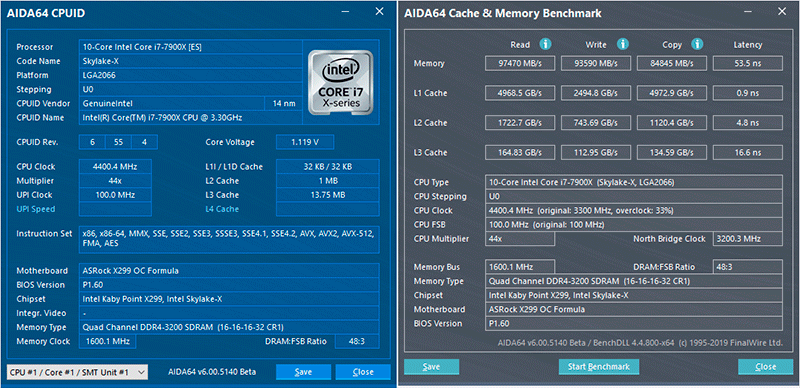
In turn, 16 gigabytes of DDR4 RAM operated in four-channel mode at 3.2 GHz with main timings 15-16-16-32 CR1 at 1.35 V and adjusting individual secondary timings. The maximum performance level in today’s article will be set by the Gigabyte GeForce RTX 2070 SUPER Gaming OC at its nominal frequencies.
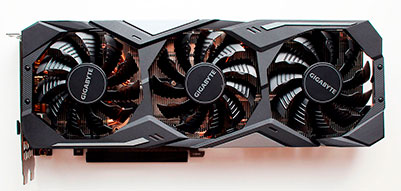
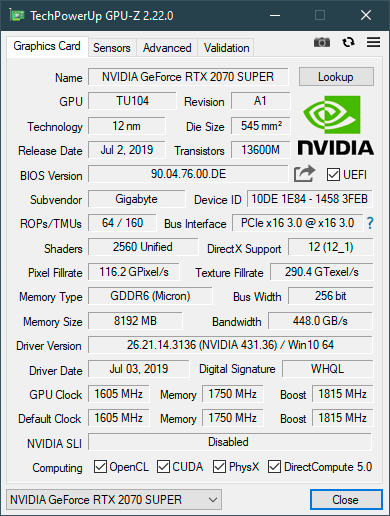
Direct competitors of AMD Radeon RX 5700 today will be NVIDIA GeForce RTX 2060 SUPER Founders Edition and the same video card without the SUPER prefix.
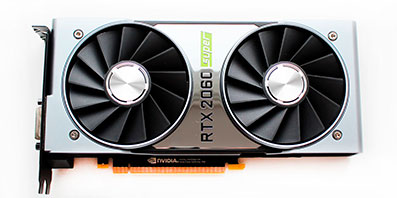
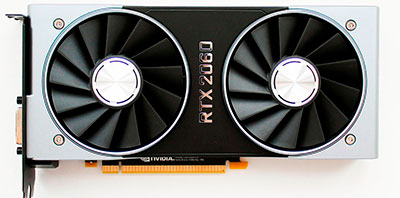
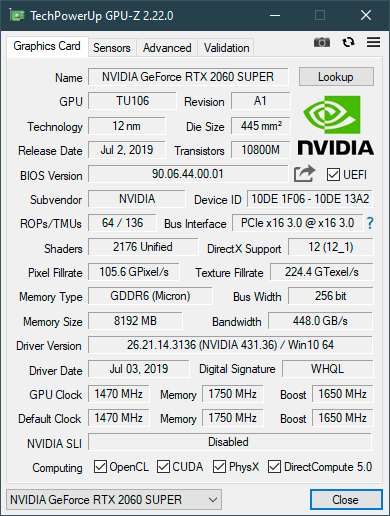
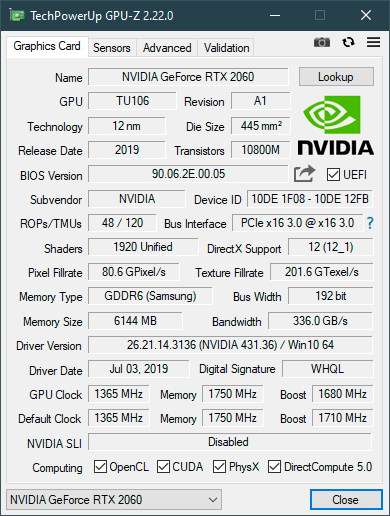
The power and temperature limits on all NVIDIA graphics cards were increased to the maximum possible, and in the GeForce drivers, instead of optimal power consumption, the priority was given to maximum performance. Testing, which began on August 16, 2019, was carried out under the operating system Microsoft Windows 10 Pro 1903 with all updates as of the specified date and with the installation of the following drivers: motherboard chipset Intel Chipset Drivers – 10.1.18019.8144 WHQL dated 03/05/2019; Intel Management Engine Interface (MEI) – 1923.12.0.1278 WHQL from 06/20/2019; drivers for video cards on NVIDIA graphics processors – GeForce 431.36 WHQL from 07/09/2019 ;
The driver of the video card on the AMD graphics processor is AMD Radeon Adrenalin Edition 19.7.5 from 07/31/2019 .
In today’s testing, we only used 2560 x 1440 pixels. Two graphics quality modes were used for the tests: “Quality + AF16x” – the quality of textures in the drivers by default with anisotropic filtering at 16x and “Quality + AF16x + MSAA 4x” with anisotropic filtering at 16x and full-screen anti-aliasing using the MSAA algorithm of degree 4x … In some games, due to the specifics of their game engines, other anti-aliasing algorithms were used, which will be indicated later in the methodology. Anisotropic filtering and full-screen anti-aliasing was enabled in the game settings. Vertical Sync (V-Sync) is forcibly disabled. Apart from the above, no additional changes were made to the driver settings.
The video cards have been tested in two graphics tests and fifteen games, updated to the latest versions as of the date of the publication. The current list of test applications is as follows (games and further test results in them are arranged in the order of their official release):
3DMark (DirectX 9/11/12) – version 2.9.6631, testing in scenes Fire Strike Extreme, Fire Strike Ultra, Time Spy Extreme and Port Royale (graphical score is shown on the diagram);
Unigine Superposition (DirectX 11) – version 1.0, tested in 1080P High, 1080P Extreme and 4K Optimized settings;
Deus Ex: Mankind Divided(DirectX 12) – version 1.19 build 801.0, all quality settings are manually set to the maximum level, tessellation and depth of field are activated, at least two consecutive runs of the benchmark built into the game;
For Honor (DirectX 11) – version 70.113, maximum graphics quality settings, volumetric lighting – MHBAO, dynamic reflections and blur effect enabled, anti-aliasing oversampling disabled, tests without anti-aliasing and with TAA, double sequential run of the benchmark built into the game;
Tom Clancy’s Ghost Recon Wildlands (DirectX 12) – version 1.6.0, graphics quality settings to maximum or Ultra-level, all options are activated, tests without anti-aliasing and with SMAA + FXAA, double sequential run of the benchmark built into the game;
Warhammer 40,000: Dawn of War III (DirectX 11) – version 4.0.0.19122, all graphics quality settings to the maximum level, anti-aliasing is activated, but in AA mode, resolution scaling up to 150% was used, a double sequential run of the benchmark built into the game;
Call of Duty: WWII (DirectX 11) – version 1.24.01, all graphics quality settings at the extra level, shadows are enabled, testing without anti-aliasing and when the SMAA T2X option is activated, a double run of the opening scene of the first stage of D-Day was used, FRAPS 105 seconds;
Strange brigade(DirectX 12) – version 1.47.22.14, setting level “Ultra”, all quality improvement techniques are activated, asynchronous computation is enabled, two consecutive test cycles of the built-in benchmark without anti-aliasing and with its activation;
Shadow of the Tomb Raider (DirectX 12) – version 1.0 build 292, all parameters to the Ultra level, Ambient Occlusion – HBAO +, tessellation and other quality improvement techniques are activated, two test cycles of the built-in benchmark without anti-aliasing and with SMAA4x activation;
Assassin’s Creed Odyssey (DirectX 11) – version 1.51, the built-in game benchmark was used with the Ultra High settings profile and disabled dynamic resolution, double test run without anti-aliasing and with anti-aliasing at the High level;
HITMAN 2(DirectX 12) – version 2.40.0, built-in test at “Ultra” detail level, SSAO enabled, shadow quality “Ultra”, memory protection disabled, test scene – “Miami”;
Metro Exodus (DirectX 12) – version 0.1.0.17, built-in performance benchmark, Ultra and RTX settings profiles, double sequential test scene;
Far Cry New Dawn (DirectX 12) – version 1.0.2, all settings to the maximum quality level – Ultra and High, motion blur enabled, built-in performance test without anti-aliasing and with TAA enabled;
Tom Clancy’s The Division 2 (DirectX 12) – version 1.0.4, frame limit disabled, all settings set to the maximum quality level, resolution of projected textures – 512, built-in performance test;
World War Z (DirectX 11) – version 1.21, FPS limitation disabled, all settings to Ultra, built-in performance benchmark without anti-aliasing and with TAA enabled;
Total War: Three Kingdoms (DirectX 11) – version 1.1.0, maximum graphics quality, shadow detail and squad size at Extreme level, built-in performance benchmark without anti-aliasing and with TAA activation;
F1 2019 (DirectX 12) – version 1.06, the built-in game test was used on the Albert Park track in Australia in clear weather, the graphics quality settings were set to the maximum level for all points, the SSRT shadows were activated, the test was without anti-aliasing and with TAA.
Let’s add that if the games have implemented the ability to fix the minimum number of frames per second, then it was also shown in the diagrams. Each test was carried out twice, the best of the two obtained values was taken as the final result, but only if the difference between them did not exceed 1%. If the deviations of the benchmark runs exceeded 1%, then the testing was repeated at least one more time to get a reliable result.
3. Results of performance tests
3DMark
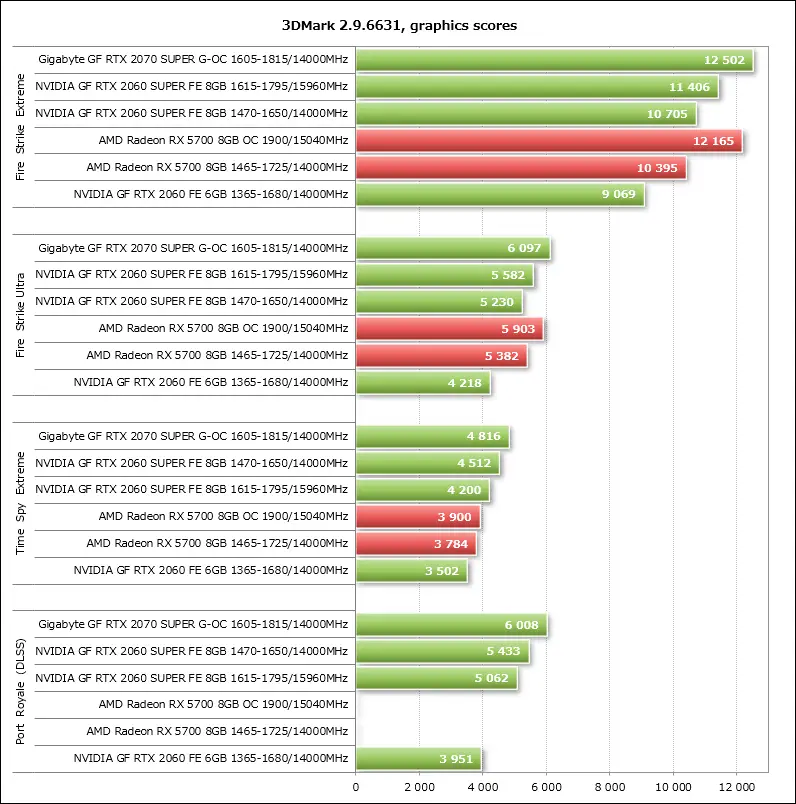
Unigine Superposition
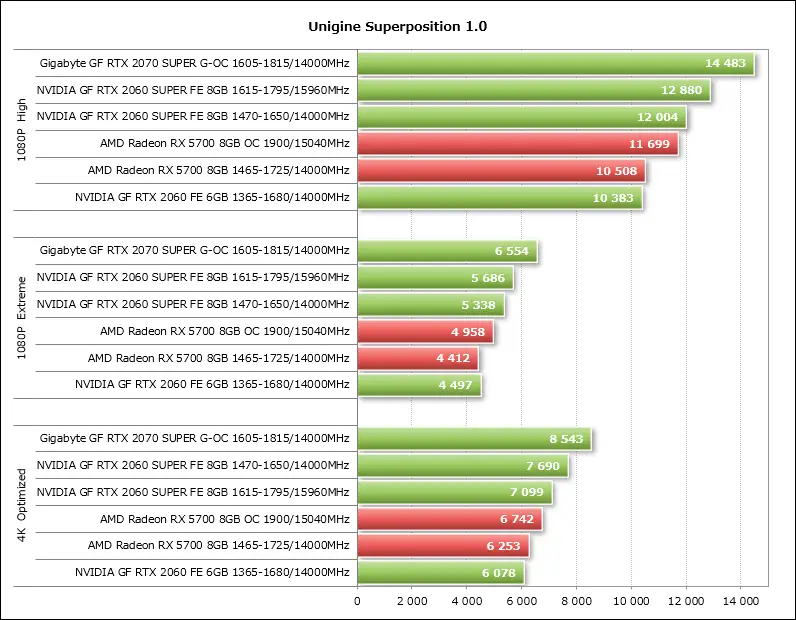
Deus Ex: Mankind Divided
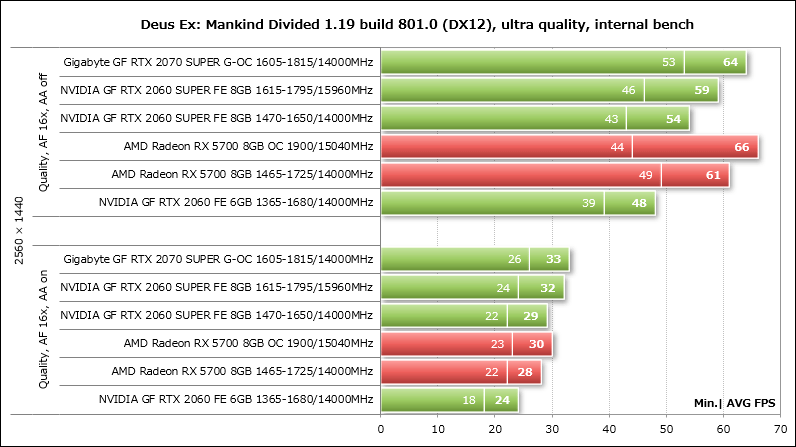
For Honor
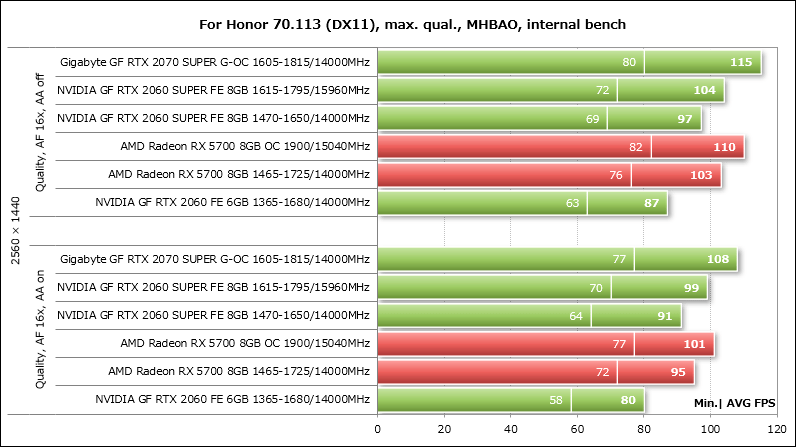
Tom Clancy’s Ghost Recon Wildlands
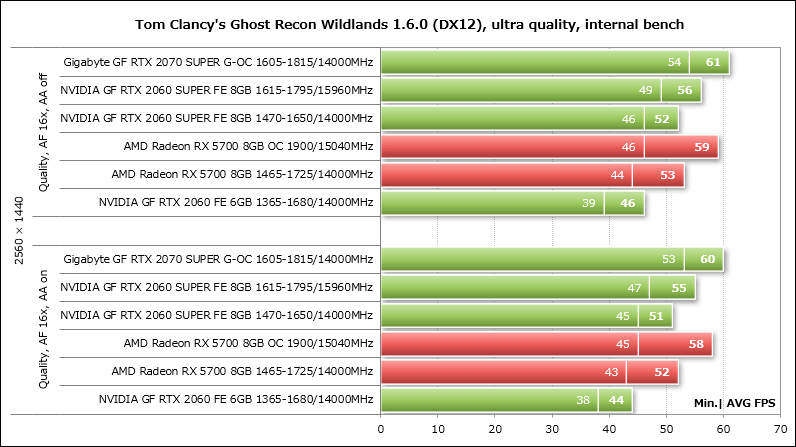
Warhammer 40,000: Dawn of War III
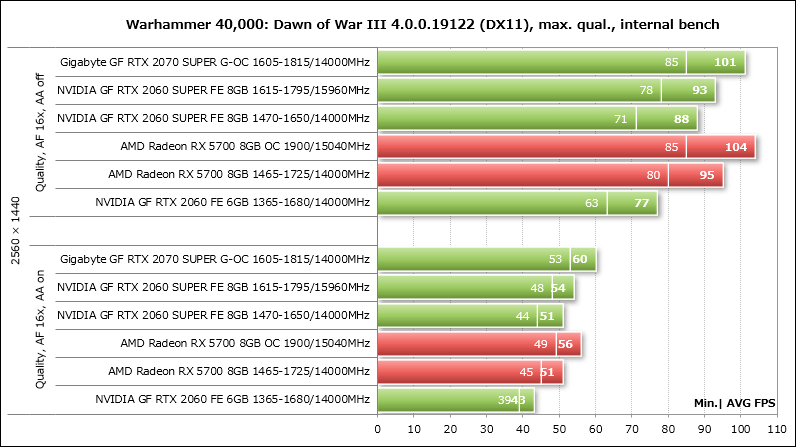
Call of Duty: WWII
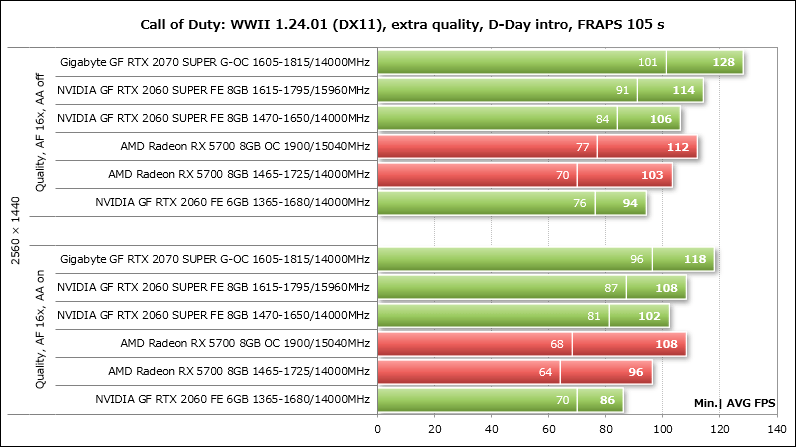
Strange Brigade
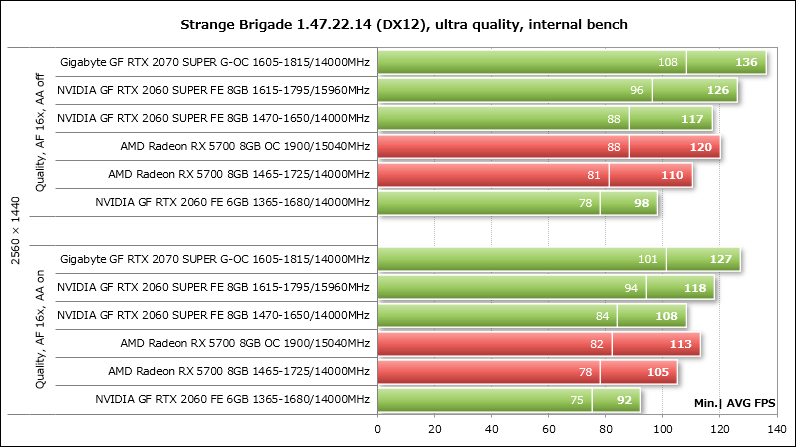
Shadow of the Tomb Raider
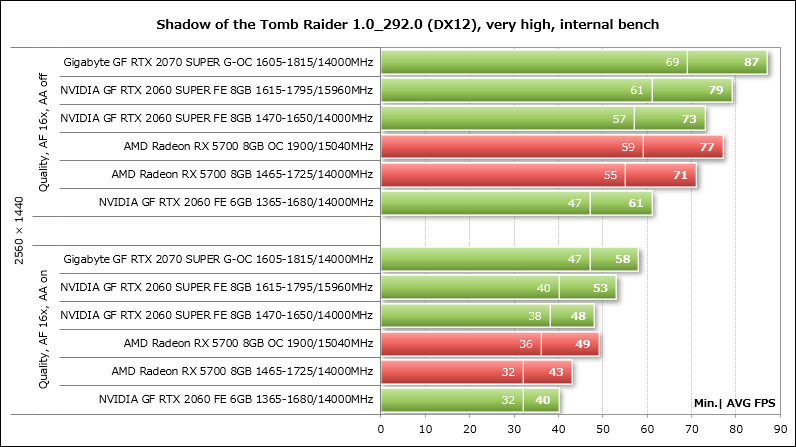
Assassin’s Creed Odyssey
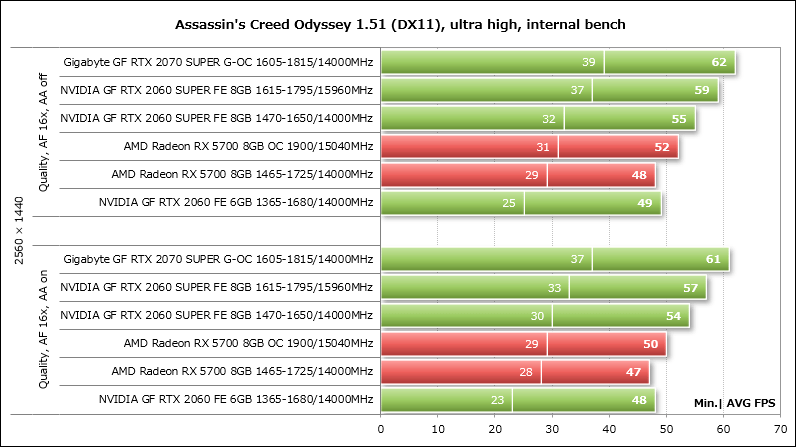
HITMAN 2
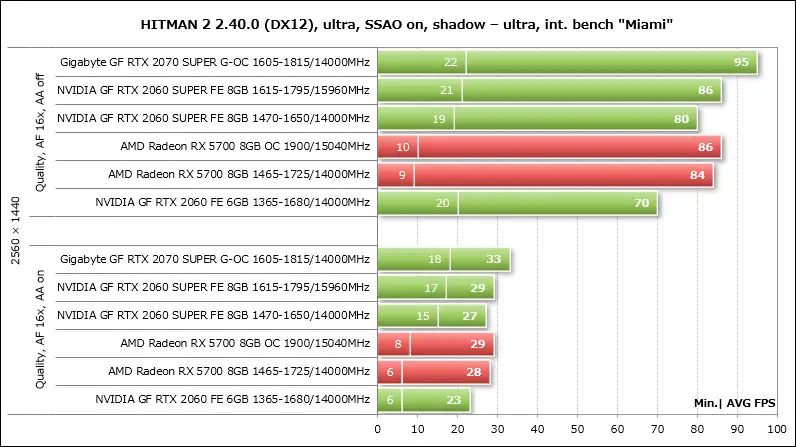
Metro Exodus
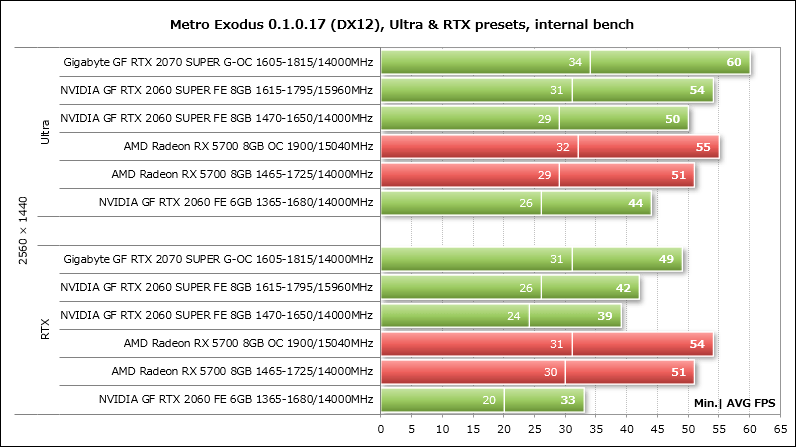
Far Cry New Dawn
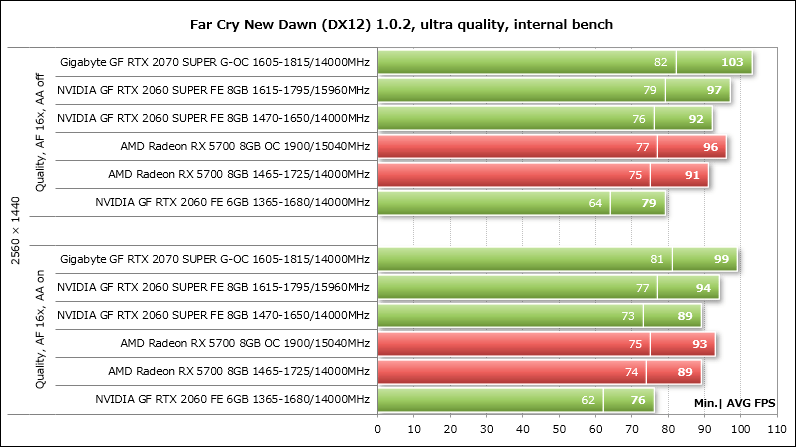
Tom Clancy’s The Division 2
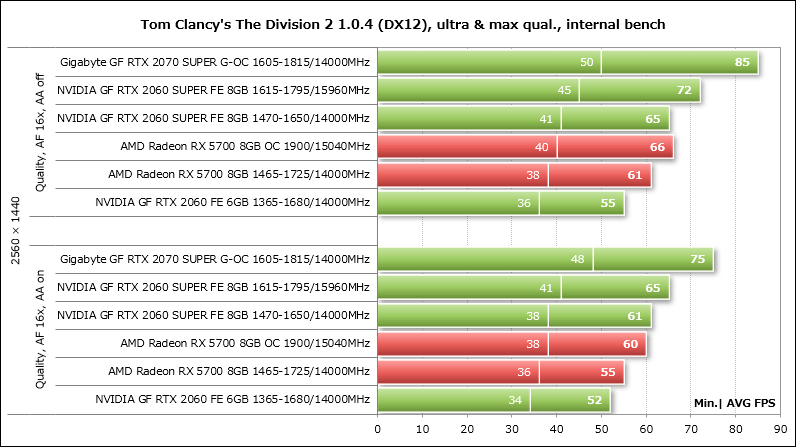
World War Z
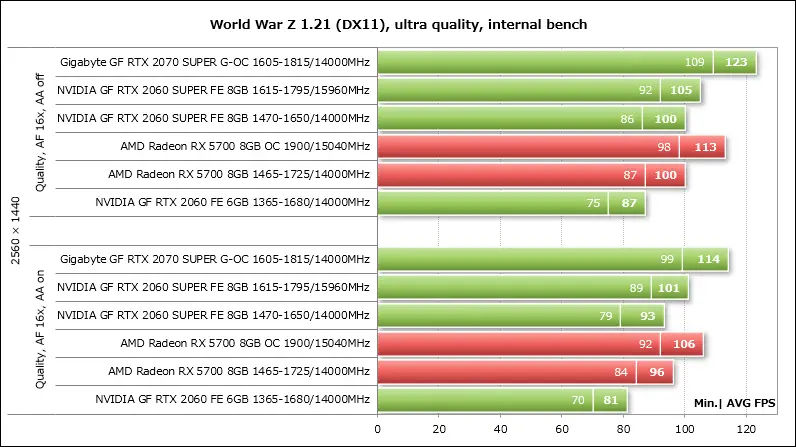
Total War: Three Kingdoms
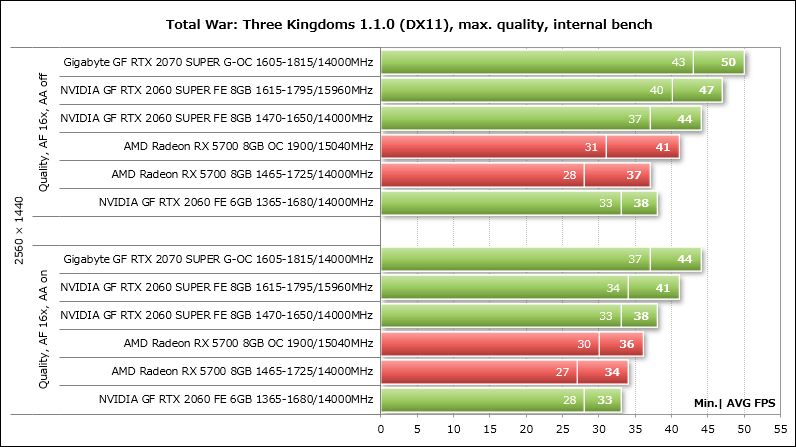
F1 2019
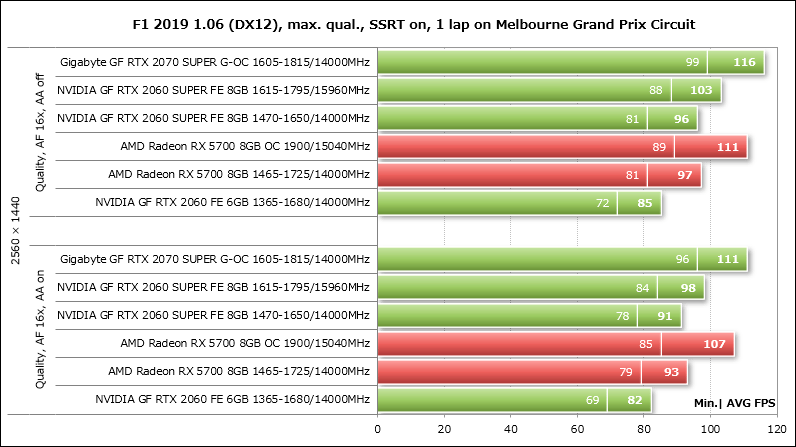
Let’s supplement the constructed diagrams with a summary table with test results with the displayed average and minimum value of the number of frames per second for each video card.
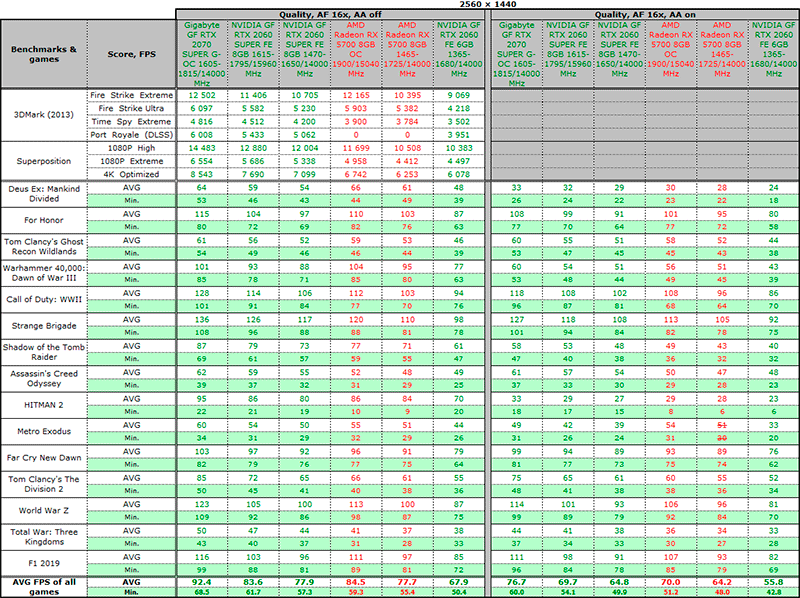
We will analyze the results using summary diagrams.
4. Summary charts and analysis of results
In the first summary diagram, we propose to compare the performance of the reference AMD Radeon RX 5700 and NVIDIA GeForce RTX 2060 SUPER, the results in game tests of which are taken as the zero axis, and the performance of a video card on an AMD GPU is reflected in percentage deviations from it.
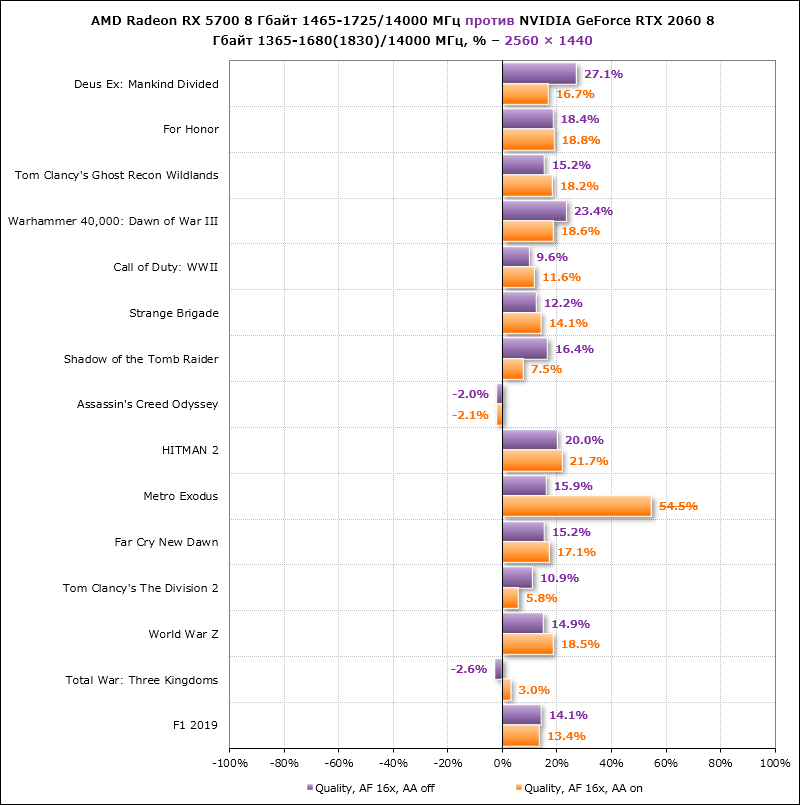
The old model NVIDIA GeForce RTX 2060 is only able to withstand the new AMD product in Assassin’s Creed Odyssey and Total War: Three Kingdoms. In other games, the Radeon RX 5700 is faster, and on average its advantage (excluding the indicator in the “RTX” test mode of the Metro Exodus game) is 13.9% without anti-aliasing and 13.1% when it is activated. Not surprisingly, NVIDIA preemptively released the faster GeForce RTX 2060 SUPER, compared to the Radeon RX 5700 in the second pivot chart.
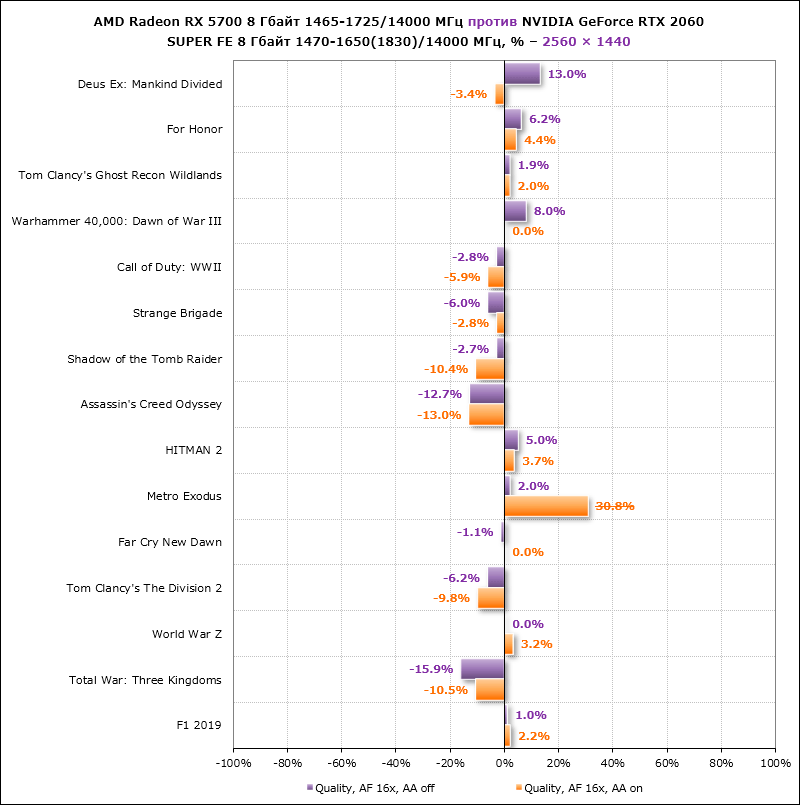
Here the struggle is already being waged with varying success. In some games, AMD retains the advantage, while in others NVIDIA is a little faster. If we evaluate the situation together, then we would say that AMD Radeon RX 5700 and NVIDIA GeForce RTX 2060 SUPER are equal in performance. At the same time, let’s not forget that the cost of the RX 5700 in the Russian market is slightly lower than the price of the RTX 2060 SUPER. Now let’s see how much the AMD Radeon RX 5700 adds to the performance when overclocking (tuning) the GPU and video memory.
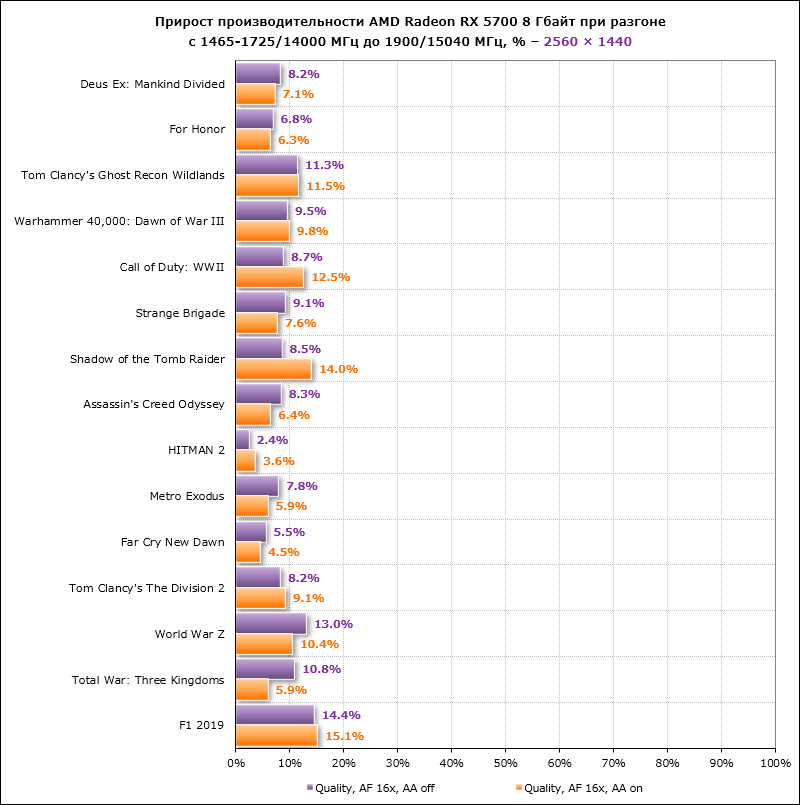
A very confident increase in performance, averaging 8.8% for all games without anti-aliasing and 8.6% when activating its various methods. And since we have previously overclocked NVIDIA GeForce RTX 2060 SUPER , then on the last summary diagram we will compare the performance of two overclocked video cards.
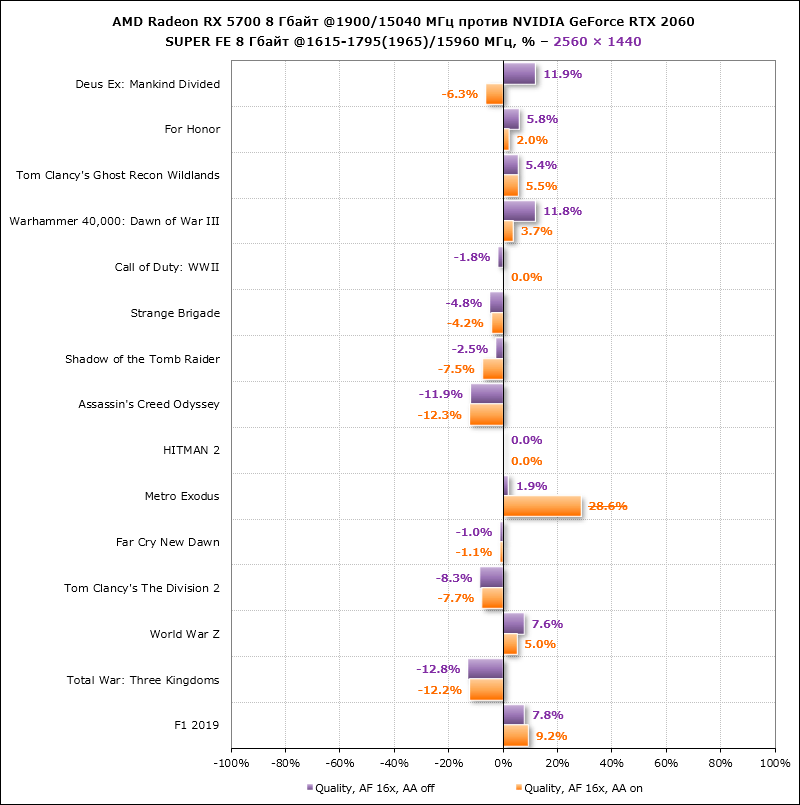
Since in the previous article NVIDIA GeForce RTX 2060 SUPER we also overclocked very well, we do not see any fundamental changes in the confrontation with the overclocked Radeon RX 5700.
5. Power consumption
To measure the power consumption of video cards, we used the NVIDIA FrameView utility , from the logs of which, for each tested video card, the diagram shows the minimum power consumption of the graphics processor (GPUOnlyPower (W)) and its maximum value, as well as the maximum power consumption of the entire video card (TotalPower (W)) … For the load in this test, we used the HITMAN 2 game benchmark at a resolution of 2560 × 1440 pixels with maximum graphics quality settings and activated anti-aliasing. Let’s see the results.
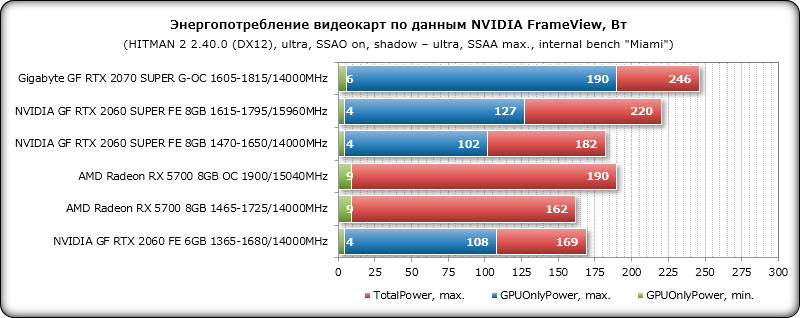
AMD Radeon RX 5700 with seven-nanometer GPU Navi 10 Pro turned out to be the most economical video card in the nominal operating mode, and when overclocked it consumes only slightly more than the overclocked NVIDIA GeForce RTX 2060 SUPER. This is an undoubted success for AMD, because, to be honest, previous AMD GPUs and video cards based on them could not boast of high energy efficiency. With the release of the new AMD Radeon RX 5700 and RX 5700 XT, the situation has changed, which is good news. In addition, we note that in our test configuration, the Radeon RX 5700 required less than 450 watts of total power.
Outcomes
AMD Radeon RX 5700 is undoubtedly a very successful and promising video card that successfully opposes competitors in its price segment. If NVIDIA had not released the new SUPER version of the GeForce RTX 2060, which, in fairness, is now a little more expensive, today we could talk about a definite victory for the Radeon RX 5700. Now, in general, we are observing parity in performance, not counting one-time victories depending on the specifics of the game engines.
In terms of power consumption, AMD is even a winner, but the difference is small and may well be ignored when choosing video cards from this pair. The only thing AMD still needs to work on is the design of the reference samples. They, unlike the competitor, turned out to be very noisy and hot. In fact, reference design video cards can only be overclocked at the cost of very high noise levels, not suitable for home use. Therefore, we would recommend choosing from the original versions with efficient coolers, of which there are already more and more.
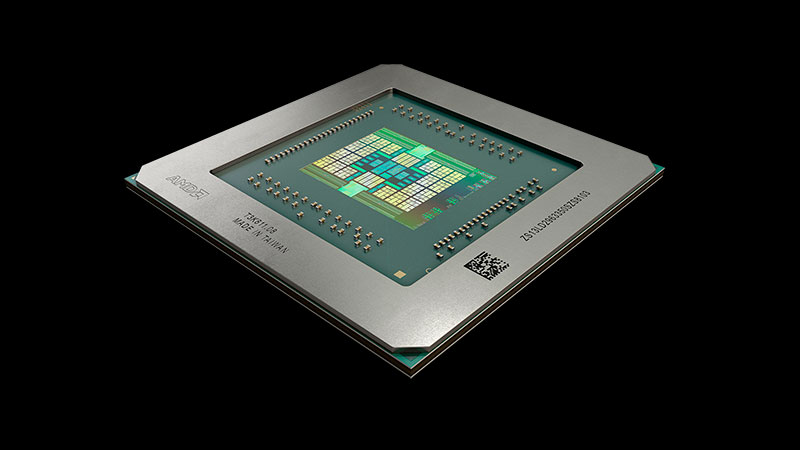
Video cards based on Radeon RX 5700 and RX 5700 XT – in our price list!





